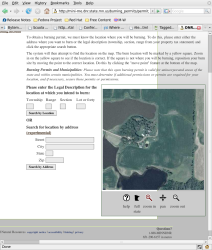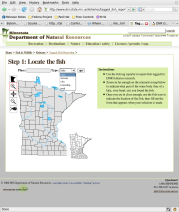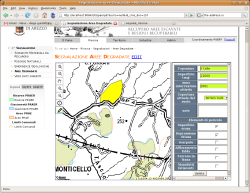Author: Marco Fioretti
Many public administrations already use open source Geographic Information Systems (GIS) to let citizens look at public geographic data trough dedicated Web sites. Others use the same software to partially open the data gathering process: they let citizens directly add geographic information to the official, high-quality GIS databases by drawing or clicking on digital maps.
For instance, the online burning permit sales service of the Minnesota Department of Natural Resources (DNR) allows citizens to declare precisely where they would like to burn woody debris. High precision is essential in deciding whether a permit is obtainable, as well as when and under what conditions: if there is a high fire risk in the area and day for which a user asks for a permit, the software must refuse it. The Web site, however, makes it easy to enter the location with the greatest possible resolution: users first type an address into a form to get an approximate location on the map, then zoom at will and finally click on the exact spot for which they are applying for a permit.
There are three immediate benefits in this procedure. Single citizens save money and trips to the local fire warden. The community as a whole saves money too, since permits are managed via computer, and also gains in safety. All burning locations appear on one separate digital map as soon as their permits are granted, giving to emergency response teams “a synoptic, real-time view of who is burning where which was simply never available before”, as DNR employee Steve Lime puts it.
Another DNR application works in a similar way to capture locations where tagged fish were caught: you zoom in until you can click on the exact point of the lake or river where you found the fish, then enter a code found on the fish’s tag and other relevant details. The Web site also won an Award from the Organization of Fish and Wildlife Information Managers for the best wildlife-related GIS Web-based Technical Application.
In Italy’s Tuscan province of Arezzo a new GIS system, announced at the 2008 GFOSS day in Italy will soon let selected, registered citizens enter more complex geographic data. Single professionals and employees of environmental or professional associations will be able to draw single points and polygons to enter the exact location, shape, and approximate area of several landscape features or hazards, such as natural resources and landfills with environmental or geologic hazards.
All of these portals run well-known open source software. The common part is MapServer, developed in Minnesota by Lime and others, which can build digital maps on the fly and serve them over the Web. Both DNR Web sites use custom scripts in Perl or Ruby on Rails that connect all the other parts to PostGIS or MySQL database back ends. Besides MapServer and PostGIS, the Arezzo Web site will run on Java and Apache Tomcat as servlet engine. The DNR Web pages communicate with MapServer through the dBox DHTML Web mapping library, developed by Lime and others at DNR. Lime says DNR plans not to use dBox for any new development, since “there are now better tools, such as OpenLayers, available.” For geocoding — that is, mapping street addresses to geographic coordinates — DNR uses the Yahoo! Maps geocoding API, which the organization found more accurate than Google for rural areas of Minnesota.
The process
A non-technical but important characteristic of all these services is their integration with existing infrastructures and needs. None of these applications was invented just to impress taxpayers. They either solve well-defined, concrete problems or replace non-digital versions of procedures and services already adopted in public administrations.
More than anything else, these Web sites are relevant because of the way they create public GIS data or implement, as they call it in Arezzo, “participated planning”: that is, what they allow citizens to do, how, and where. These are all cases in which citizens outside the public administrations can directly add to official GIS databases coordinates, areas, or other spatial data in natural formats that need no further conversion and are easily reusable in the future. What is open here is the data management process, not just the software.
The success of initiatives like OpenStreetMap or the availability of Yahoo! and Google Maps APIs may make you think that people may create services like these and many more all by themselves, without getting any bureaucrat involved. However, in order to benefit the most from digital maps and other spatial data, citizens need such data to be officially inserted in, and completely integrated with, the maps and databases public administrations use to plan roads, zoning, and everything else.
Citizens may use Web sites like those mentioned here to request services as different as bus stops, trekking permits, or new post offices. Other uses may include signalling construction abuses, damages to public property, or illegal dumpsters. We may draw our preferred public bus routes on a map in our City Council official Web site.
Of course, to make all this work in practice, public administrations should also clarify the data ownership situation. Who owns data directly and freely provided from citizens? What license should apply to those data or any derived ones? This, however, is a separate issue, not really related to open source software.
Open source GIS software is already good enough to run official, mission-critical GIS sites and services. These examples prove another, probably more important point: open source GIS can be used to get citizens directly involved in the management of public data and property. Indeed, it may be the only feasible way to achieve such a goal.
Categories:
- News
- Internet & WWW
- Enterprise Applications





